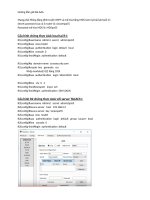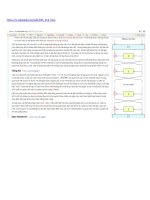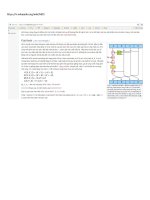Tài liệu môn Thiết Kế Mạng - Võ Tấn Dũng (votandung) Chapter05
Bạn đang xem bản rút gọn của tài liệu. Xem và tải ngay bản đầy đủ của tài liệu tại đây (1000.27 KB, 35 trang )
Top-Down Network Design
Chapter Five
Designing a Network Topology
Copyright 2010 Cisco Press & Priscilla Oppenheimer
Topology
• A branch of mathematics concerned with those
properties of geometric configurations that are
unaltered by elastic deformations such as
stretching or twisting
• A term used in the computer networking field to
describe the structure of a network
Network Topology Design
Themes
•
•
•
•
•
Hierarchy
Redundancy
Modularity
Well-defined entries and exits
Protected perimeters
Why Use a Hierarchical Model?
• Reduces workload on network devices
– Avoids devices having to communicate with too
many other devices (reduces “CPU adjacencies”)
•
•
•
•
Constrains broadcast domains
Enhances simplicity and understanding
Facilitates changes
Facilitates scaling to a larger size
Hierarchical Network Design
Campus A
Enterprise WAN
Backbone
Core Layer
Campus B
Campus C
Campus C Backbone
Access Layer
Building C-1
Building C-2
Distribution
Layer
Cisco’s Hierarchical Design
Model
• A core layer of high-end routers and
switches that are optimized for availability
and speed
• A distribution layer of routers and switches
that implement policies and segment traffic
• An access layer that connects users via
hubs, switches, and other devices
Flat Versus Hierarchy
Headquarters in
Medford
Headquarters in
Medford
Grants Pass
Branch Office
Klamath Falls
Branch Office
Ashland
Branch
Office
Flat Loop Topology
Grants Pass
Branch
Office
Klamath Falls
Branch Office
Ashland
Branch
Office
White City
Branch Office
Hierarchical Redundant Topology
Mesh
Designs
Partial-Mesh Topology
Full-Mesh Topology
A Partial-Mesh Hierarchical Design
Headquarters
(Core Layer)
Regional
Offices
(Distribution
Layer)
Branch Offices (Access Layer)
A Hub-and-Spoke Hierarchical Topology
Corporate
Headquarters
Branch Office
Home Office
Branch Office
Avoid Chains and Backdoors
Core Layer
Distribution Layer
Access Layer
Chain
Backdoor
How Do You Know When You
Have a Good Design?
• When you already know how to add a new building,
floor, WAN link, remote site, e-commerce service, and
so on
• When new additions cause only local change, to the
directly-connected devices
• When your network can double or triple in size without
major design changes
• When troubleshooting is easy because there are no
complex protocol interactions to wrap your brain around
Cisco’s SAFE Security Reference
Architecture
Campus Topology Design
•
•
•
•
Use a hierarchical, modular approach
Minimize the size of bandwidth domains
Minimize the size of broadcast domains
Provide redundancy
– Mirrored servers
– Multiple ways for workstations to reach a
router for off-net communications
A Simple Campus Redundant Design
Host A
LAN X
Switch 1
Switch 2
LAN Y
Host B
Bridges and Switches use SpanningTree Protocol (STP) to Avoid Loops
Host A
LAN X
X Switch 2
Switch 1
LAN Y
Host B
Bridges (Switches) Running STP
• Participate with other bridges in the election of a single bridge as the
Root Bridge.
• Calculate the distance of the shortest path to the Root Bridge and
choose a port (known as the Root Port) that provides the shortest
path to the Root Bridge.
• For each LAN segment, elect a Designated Bridge and a Designated
Port on that bridge. The Designated Port is a port on the LAN
segment that is closest to the Root Bridge. (All ports on the Root
Bridge are Designated Ports.)
• Select bridge ports to be included in the spanning tree. The ports
selected are the Root Ports and Designated Ports. These ports
forward traffic. Other ports block traffic.
Elect a Root
Bridge A ID =
80.00.00.00.0C.AA.AA.AA
Lowest Bridge ID
Wins!
Root
Bridge A
Port 1
Port 2
LAN Segment 1
100Mbps Ethernet
Cost = 19
LAN Segment 2
100Mbps Ethernet
Cost = 19
Port 1
Port 1
Bridge B
Bridge C
Port 2
Port 2
Bridge B ID =
80.00.00.00.0C.BB.BB.BB
Bridge C ID =
80.00.00.00.0C.CC.CC.CC
LAN Segment 3
100Mbps Ethernet
Cost = 19
Determine Root Ports
Bridge A ID =
80.00.00.00.0C.AA.AA.AA
Root
Bridge A
Port 1
Lowest Cost
Wins!
Port 2
LAN Segment 1
100Mbps Ethernet
Cost = 19
LAN Segment 2
100Mbps Ethernet
Cost = 19
Root Port
Root Port
Port 1
Port 1
Bridge B
Bridge C
Port 2
Port 2
Bridge B ID =
80.00.00.00.0C.BB.BB.BB
Bridge C ID =
80.00.00.00.0C.CC.CC.CC
LAN Segment 3
100Mbps Ethernet
Cost = 19
Determine Designated Ports
Bridge A ID =
80.00.00.00.0C.AA.AA.AA
Root
Bridge A
Designated Port
Designated Port
Port 1
Port 2
LAN Segment 1
100Mbps Ethernet
Cost = 19
LAN Segment 2
100Mbps Ethernet
Cost = 19
Root Port
Root Port
Port 1
Port 1
Bridge B
Bridge C
Port 2
Port 2
Bridge B ID =
80.00.00.00.0C.BB.BB.BB
Designated Port
Lowest Bridge ID
Wins!
Bridge C ID =
80.00.00.00.0C.CC.CC.CC
LAN Segment 3
100Mbps Ethernet
Cost = 19
Prune Topology into a Tree!
Bridge A ID =
80.00.00.00.0C.AA.AA.AA
Root
Bridge A
Designated Port
Designated Port
Port 1
Port 2
LAN Segment 1
100Mbps Ethernet
Cost = 19
LAN Segment 2
100Mbps Ethernet
Cost = 19
Root Port
Root Port
Port 1
Port 1
Bridge B
Bridge C
Port 2
Port 2
Bridge B ID =
80.00.00.00.0C.BB.BB.BB
Designated Port
Bridge C ID =
80.00.00.00.0C.CC.CC.CC
LAN Segment 3
100Mbps Ethernet
Cost = 19
X
Blocked Port
React to Changes
Bridge A ID =
80.00.00.00.0C.AA.AA.AA
Root
Bridge A
Designated Port
Designated Port
Port 1
Port 2
LAN Segment 1
LAN Segment 2
Root Port
Root Port
Port 1
Port 1
Bridge B
Bridge C
Port 2
Port 2
Bridge B ID =
80.00.00.00.0C.BB.BB.BB
Designated Port Becomes
Disabled
Bridge C ID =
80.00.00.00.0C.CC.CC.CC
LAN Segment 3
Blocked Port Transitions to
Forwarding State
Scaling the Spanning Tree
Protocol
• Keep the switched network small
– It shouldn’t span more than seven switches
• Use BPDU skew detection on Cisco switches
• Use IEEE 802.1w
– Provides rapid reconfiguration of the spanning
tree
– Also known as RSTP
Virtual LANs (VLANs)
• An emulation of a standard LAN that allows
data transfer to take place without the
traditional physical restraints placed on a
network
• A set of devices that belong to an
administrative group
• Designers use VLANs to constrain broadcast
traffic
VLANs versus Real LANs
Switch A
Station A1
Station A2
Network A
Switch B
Station A3
Station B1
Station B2
Network B
Station B3









